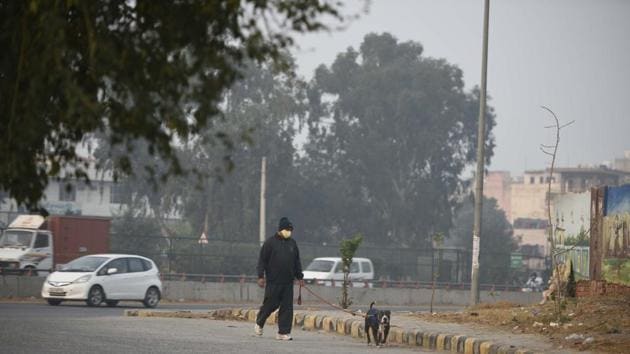Stubble fires come down; NW India breathes easy for now
Compared to the past three years, air quality is considerably better this year in many north-western towns from November 13 to 17, shows data from Central Pollution Control Board’s air quality index bulletins
Most parts of northwest India experienced blue skies and “satisfactory” and “moderate” air quality after a spell of “severe” air quality last week following widespread rains and snowfall in the hills and north-western plains on Sunday.

Stubble fires in Punjab have also stopped with the Kharif harvest season coming to an end. This year, paddy yield in Punjab is likely to be 22% higher than last year, according to Indian Council of Agricultural Research (ICAR).
Compared to the past three years, air quality is considerably better this year in many north-western towns from November 13 to 17, shows data from Central Pollution Control Board’s air quality index bulletins. On Wednesday morning also, the air quality index in northwestern towns and cities like Amritsar, Baghpat, Bahadurgarh, Bathinda, Delhi, Faridabad, Ghaziabad, Gurugram and Karnal etc was in “moderate” and “satisfactory” category.
Even though Diwali this year was celebrated on November 14, a combination of favourable meteorology and tapering off of crop stubble fires in Punjab and Haryana has led to air pollution levels dropping significantly from November 15 onwards. The accumulation of pollutants from stubble fires and Diwali firecrackers has dispersed, scientists said.
Also read | Focus on local emissions to avoid return of bad air
“Unlike previous years when stubble fires would coincide and linger after Diwali, this time after Diwali, fires have also reduced and the accumulated pollution has been dispersed due to strong winds and rain after an active Western Disturbance that impacted the Western Himalayan region on November 14. Even though the wind direction changed from easterly to northwesterly on Tuesday, if there are no stubble fires, we do not expect air pollution levels to spike again. Wind speed will continue to be moderate over 10 kmph for the next few days,” said Kuldeep Shrivastava, head, regional weather forecasting centre.
With the switch to northwesterly wind direction, minimum temperature is likely to drop gradually. On Monday, the minimum temperature in Delhi was 16 degree C, 2 degree C above normal and on Tuesday, it came down to 13 degree C , 1 degree C above normal. “We can expect minimum temperature to fall by another 3 degree C to about 10 degrees on Wednesday,” Shrivastava added.
Under the influence of a fresh Western Disturbance, light isolated to scattered rain and snow is very likely over Western Himalayan region from November 18 to 20 once again. Minimum temperatures are likely to fall gradually by 2-4 degree C over northwest India and north Madhya Pradesh during the next 4-5 days according to India Meteorological Department’s Tuesday bulletin.
“What we are seeing now is because of very good wind speed following rain and snowfall in many parts of northwest India. The ventilation index in Delhi on Tuesday is over 10,000 m2. The mixing height is also very good. The pollution accumulated over the past few days has dispersed. The life of PM 2.5 particles (fine, respirable pollution particles) is about 3 days but it is now getting dispersed. Though wind direction has changed to north-westerly pollution levels have not increased. This is also because emissions from stubble fires have nearly stopped now,” said Vijay Soni, scientist at IMD’s air quality division.
The ventilation index is a function of the mixing height (the height at which pollutants mix in the air) and the wind speed and defines the ability of the atmosphere to disperse contaminants. A ventilation index below 2,350 sq metres/second is considered poor.
Farmers in Punjab and the ICAR confirmed that harvesting for the Kharif season is nearly complete. “Air pollution levels have dropped in Punjab also. Fires have reduced because harvest is over. We had a very good crop this year. Whatever fires were left have been dampened after rain. We don’t expect more fires now,” said Harinder Singh Lakhowal, Bharatiya Kisan Union general secretary, Punjab.
“The arrival of paddy is 209.56 lakh tonnes up to November 17, around 22.8% higher than last year’s 170.64 lakh tonnes. Last year, the total arrival was around 188.9 lakh tonnes during whole season,” said Trilochan Mohapatra, director general, ICAR.
“This reduction in air pollution has been possible partly because fire counts have reduced to almost zero and meteorological factors have been favourable. Now that we have a Commission for air quality management in NCR and adjoining areas, I am hoping there will be strict compliance of emissions from the industrial sector, from power plants and brick kilns. Personally, I hope to see a reduction in air pollution levels compared to 2018 and 2019,” said Sagnik Dey, associate professor at IIT Delhi.
Get Current Updates on India News, Lok Sabha Election 2024 live, Elections 2024, Election 2024 Date along with Latest News and Top Headlines from India and around the world.



